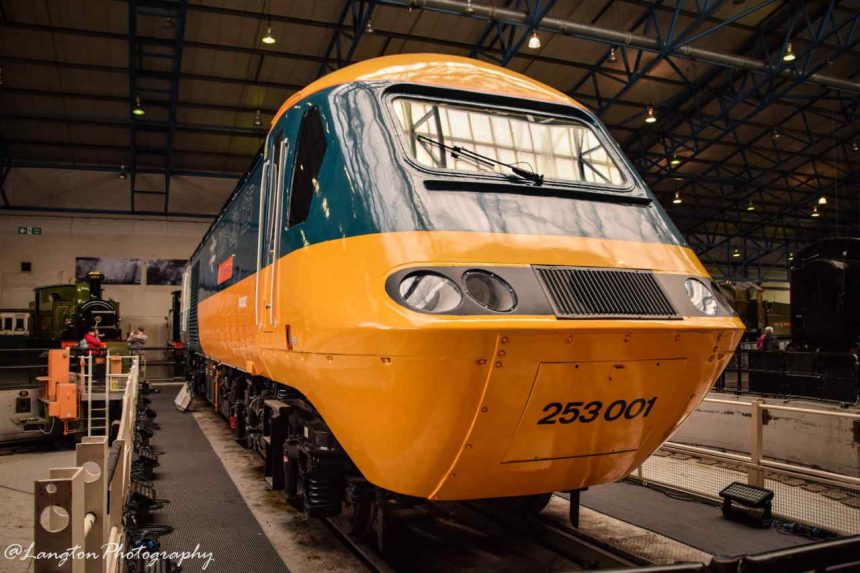Class 43 No. 43002 Sir Kenneth Grange has joined the National Railway Museum's collection after more than 40 years in service.
The Class 43 also known as the InterCity 125 has been donated by Angel Trains and Great Western Railway.
The HST has been a familiar sight on the UK rail network since the first of its type were introduced in 1976.
The locomotive is the first production HST and carries the original yellow and blue British Rail livery which led to the train's nickname – ‘the Flying Banana'.
We have spoken to the National Railway Museum about the Flying Banana comment above, and whilst the Network Rail measurement train is now known as the Flying Banana, previously, the BR yellow and blue livery was also known as the Flying Banana.
The locomotive is named after the train's designer, Sir Kenneth Grange, who created the iconic wedge-shaped nose cone.
Power car no. 43002 was built in the same year the National Railway Museum first opened in 1975. The HST was initially the fastest train in Europe and was only beaten by the Japanese Bullet Train internationally.
The HST class still holds the world diesel speed record of 148mph which was set on 1 November 1987.
The HST power car is now on static public display at the centre of the National Railway Museum's Great Hall.
The Class 43s were replaced by Great Western Railway with brand new Class 800s ‘Intercity Express Trains' by Hitachi.
What did the officials say?
Andrew McLean, Assistant Director and Head Curator at the National Railway Museum, said:
“This is one of our most significant acquisitions, and I am delighted to be able to display the HST power car, Sir Kenneth Grange here in York. It is fair to say that this train revolutionised rail travel and helped shape British society, bringing people and communities together.
“I would like to thank Angel Trains, Great Western Railway and Rail Operations Group for their generosity and hard work to bring this icon of British engineering into the national collection.”
Kevin Tribley, CEO at Angel Trains, said:
“The InterCity 125 is a trailblazer of the British rail industry and we are delighted to support the National Railway Museum in preserving Sir Kenneth Grange's iconic design for future generations to discover. Education is incredibly important to us at Angel Trains, as well as celebrating innovation and technology, so we are proud to donate this much-admired locomotive to the museum's extensive collection.”
Mark Hopwood, Managing Director of Great Western Railway, said:
“When introduced in 1976, these trains were a step change in InterCity travel across the country with new levels of comfort and faster journeys and the new Intercity Express Trains are building on the standards that these set.
“This particular locomotive has been a firm favourite since we returned it to its original livery in 2016 and we are really pleased to see this particular locomotive joining the National Railway Museum's collection. Our team at Laira Depot in Plymouth have done a fantastic job in preparing it for display and as the last locomotive to leave Paddington in passenger service, its place in history is rightly deserved.”
Where Next?
News Homepage
For the Latest Railway News
RailAdvent Online Shop
Framed Prints, DVD's / Blu-Ray's and more
LocoStop Community
Come and share your railway pictures
National Railway Museum
Visit their website
Mainline Steam Info
Upcoming mainline steam tours/loco movements
Langton Photography
See more photos like this one in this article

I’m sad that the Class 43 HST 125 won’t be travelling on our rails anymore. Every time I saw one, so many memories came back to me. No matter what livery it was wearing.
I was 7 years old, in 1976 standing on Durham station’s platform on a school trip, and one went speeding past and it frightened the life out of me and my friend. That was my first.
Pleased to see it’s back in the original BR colours.
Thank you 125.
At least Class 43 (43002) “Sir Kenneth Grange” or nicknamed “The Flying Banana” will have a new home at the National Railway Museum in York. Brilliant.
The head light panels aint right as on the early power cars the lights were one peace units and were more square and wasnt split in two round shaped lights made into 2 lights! I thought it would have been corrected before it got taken to the museum!!!
The flying banana comment is incorrect. This nick name evolved from the Network Tail HST train set.
Well said John, lets have it right.
Hi John,
That is exactly what i thought when i wrote the article. It is the press release from the NRM which states that this is the flying banana livery.
I have contacted them for clarification
Regards
Michael